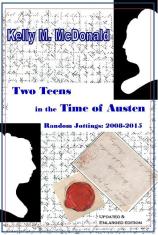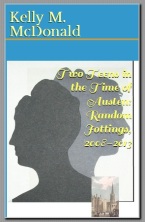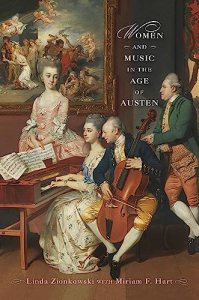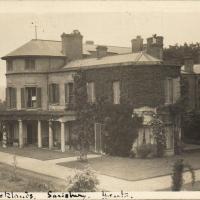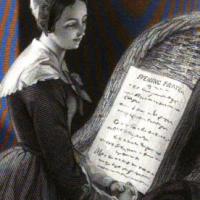La Belle Miss Linwood
La Belle Assemblée for November, 1821 featured this “biographical sketch” of Mary Linwood.

For an alternate post on Miss Linwood – and why she figures in the Smith & Gosling story.
“In the ranks of female talent and merit, we deem ourselves called upon to present the portrait of Miss Linwood, a lady who stands deservedly high among the female artists of this country, and who accomplishments and character place her in that galaxy of merit, which honours the sex, and distinguishes our country. Of female worth and abilities, it has ever been our ambition to present a faithful chronicle; and we consider the correct likeness of this lady will not fail to maintain the interest of our Biographical page.
“Miss Linwood is a native ow Warwickshire, and her family of high respectability: from her early years, Miss Linwood’s chief place of residence has been Leicester.
“A trifling circumstance appears to have given birth to her first essay in an art, in which she has since so eminently distinguished herself. About the year 1782, a friend sent her a large collection of prints in various styles of engraving, as mezzotinto, &c. &c.: the present elicited the taste of Miss Linwood’s mind. However, it appears they were presented with no other view than that of affording a few days amusement. But she inspected them with the eye of genius, and seems to have conceived that the force of a line-engraving might be united with the softness of a mezzotinto: but, unacquainted with the use of aquafortis in etching, a stranger to the mode of scraping a mezzotinto, and, indeed, ignorant, in a manner, of the whole art of engraving, she had, therefore, no instrument but her needle to make the experiment she had conceived: she resolved, therefore, to embody her first idea, by copying those prints she most admired, in black and puce-coloured silk upon white sarcenet; and her success was so great, that the needle promised to become a new and formidable rival to the pencil.
“Encouraged by the applause bestowed on her first essays, she made copies on a larger scale; and as Catharine II. of Russia was then the munificent protector of genius, Miss Linwood was advised to present a specimen of her works to the empress. She accordingly sent a large picture to St. Petersburgh, which, in October 1783, was presented to her Imperial Majesty by the then chief favourite, General Landskoy. The empress expressed the highest admiration of the performance, and declared it, in that branch of art, the finest, in her opinion, the world could have produced, and, at the same time, ordered Landskoy to make such a present to the artist, as should be worthy of the work, and of herself. But death countermanded the munificent command, for the general’s demise took place a few weeks afterwards, and no one in the Court of Petersburgh durst afterwards to mention his name, or any matter which had relation to him, so deeply afflicted was the imperial Catharine at his death. The picture, however, was highly distinguished, and always occupied a favoured situation in the late emperor’s palace, and still retains its honours in that of the present emperor Alexander.
“Miss Linwood’s first attempt to imitate paintings in oil, was in 1785, in which she was so successful, that she submitted to the Society for encouraging the Arts, &c. her St. Peter, from Guido; the head of King Lear, from Sir Joshua Reynolds; and a Hare, from the Houghton Collection. She was voted, for this, by the Society, a medal, on which was engraven, between two branches of laurel,
‘EXCELLENT IMITATIONS OF PICTURES IN NEEDLEWORK.’
“Between that period and 1789, she made great additions to her collection, and in that year she made the exquisite and highly celebrated copy of the Salvator Mundi, form a painting by Guido, in the Earl of Exeter’s collection, for which copy she was once offered the sum of three thousand guineas!
“We mention it as an extraordinary incident, highly resounding to the honour of the fair artist, that she wrought the first banner offered to any military association; and, in the year 1794, she presented it to the united corps of cavalry and yeomanry of Leicestershire. The design was original and extremely appropriate, and the whole finished with a neatness seldom united with such strength and force of design.
“It is yet more extraordinary in the genius of this admirable woman, that she was never regularly instructed in drawing; yet she was uncommon merit in painting, both in crayons, distemper, and colours; and her drawings are distinguished by their accuracy, taste, and spirit.
“The first idea of making an exhibition of her own works, originated in some pictures having been sent by her to the Royal Academy, which were refused admittance, the Academy being open only to paintings, drawings, and sculpture: but from every president of the Royal Academy, from the celebrated Sir Joshua Reynolds to the present, and from the most eminent artists, her works have received the most generous and unqualified praise.
“To enumerate the merits of Miss Linwood’s exhibition is scarcely requisite. Miss Linwood has produced a collection, which, considering its extent and intrinsic merit, will be deemed a monument of superior genius, and of an industry and perseverance unknown in the annals of female patience and exemplary skill.
“The most valuable picture ever produced by this lady, which exhibits the genius and the skill of the artist in the finest light, and affords the best specimen of the wonderful capabilities of this most curious art, we consider to be the Salvator Mundi. The beauties of the original picture were evidently not only carefully studied by Miss Linwood, but well understood, and the mechanical dexterity with which the truth of the finest pictural effects are produced, is most extraordinary.
“The Farmer’s Stable, after Morland, is as fine a copy of the original pictures as can be conceived, perhaps, in any branch of art; but, considered as a piece of needlework, its truth and effect in drawing and colouring, and the clear making out of the minute detail, is a rare curiosity.
“Jephthah’s Vow, a large picture, after Opie, is a fine specimen. Lady Jane Gray, form a painting by Northcote, has great beauty and merit. Hubert and Arthur, also from Northcote; Eloisa, from Opie; and the celebrated Woodman, after Barker, would alone confer on the fair artists a lasting distinction.
“We may conclude with the words of an eminent biographical writer, the works of Miss Linwood ‘exhibit an honourable history of her life.'”
{copied without correction, from the original}
Lucky Miss Linwood
Perusing letters and diaries you find references to people otherwise long lost in the ‘mists of time’. Or so I would have thought — as you will see, below, two bloggers have discovered and discussed Miss Linwood!
But back to Eliza Chute and her sister Augusta Smith…
 It was actually a letter reference that came first: Eliza Chute of The Vyne writing to her dear friend Eliza Gosling (Mary’s mum!) in August of 1798. But as Mrs Chute is travelling and discussing with MEG (as Eliza Gosling always signed her letters) the artworks she’s seen, it is easy to lose sight of MISS LINWOOD in this letter.
It was actually a letter reference that came first: Eliza Chute of The Vyne writing to her dear friend Eliza Gosling (Mary’s mum!) in August of 1798. But as Mrs Chute is travelling and discussing with MEG (as Eliza Gosling always signed her letters) the artworks she’s seen, it is easy to lose sight of MISS LINWOOD in this letter.
Sister Augusta, in her 1798 diary, however puts the focus squarely on the divine Miss L.: On Tuesday, 1 May 1798, Augusta writes, “Mr. & Mrs. Shrimpton Mrs Lefevre, Mrs. S. Lefevre Mr. Ewer, Mr. Still [Stile?] & Mrs. Young to Dinner. Went to the Exhibition & to see Miss Linwood’s Pictures in Needle Work.”
Mrs Chute is more expansive, though, giving a clue as to what it was that Miss Linwood did. The Chutes had visited Burleigh, “taking a great round on purpose to see it. I must own, that it is well worth travelling forty or fifty miles to see; tho’ I had heard much of it, still it answered nay surpassed my expectations…”
The two Elizas could now turn to the subject of art collected at Burleigh: “You know the famous picture of this collection is Christ blessing the elements by Carlo Dolci, which Miss Linwood copied so well, but who can equal the beauties of the original?”
Mrs Chute then continued discussing the painting that was so vividly fresh in her mind as she sat with pen and paper ready to tell her dear friend all her thoughts. She ends, “I think I shall be very difficult to please for a long while…”
But what of Miss Linwood?, you say! Who was she? She did what?
She “copied” paintings, by reproducing them in needlework.
When looking for any information on her yesterday, waves of biography, news, even a diary mention came up — and these two blogs:
- let Miss Vic at Jane Austen’s World — who is always so thorough — fill you in on the life of Mary Linwood.
- and see Number One London for a close-up of that portrait of Napoleon, along with other details of Linwood’s life & work.
**Both websites show the V&A portrait of Mary Linwood (by Hoppner)**
**See it for yourself at the Victoria & Albert Museum website**
It was in trying to find ANY representations of her work — what might Eliza and Augusta have seen?? — that I came across her exhibition booklet (at books.google): Miss Linwood’s Gallery of Pictures in Worsted, the 1822 edition. Might such a fragile companion once have been purchased by the Smiths or Goslings?
But all was not sunshine and light in the life of Miss Linwood… An 1839 diary of Miss Harriette Story Paige gives this glimpse into the lady’s life:
“Friday, July 12. Went to see Miss Linwood’s surprising productions in needlework; they are most of them copies, from paintings of the old masters, and being in frames, the deception is perfect at a short distance. For one piece, a copy of a head of our Saviour from Carlo Dolce, we were told, Miss Linwood had been offered 20,000 guineas. Miss Linwood is now 82 years old, her eye-sight, within the last five years has failed, and of course these are her last productions. It is certainly a very interesting monument of taste, and industry; the ‘death of Abel’ she completed about five years ago, and it is difficult to believe, that the whole effect, is entirely produced by stitches….; this exhibition for many years, has been one of the ‘Lions’…”
And truly sad is to see the lady in court! See Reports of Cases Argued… (1827) (1839)
But to leave Miss Linwood on a happier note: If any readers come across her actual works, please do tell!
P.S. to all listening, as I am, to the Vienna New Year’s Day concert — Prosit Neu Jahr!
